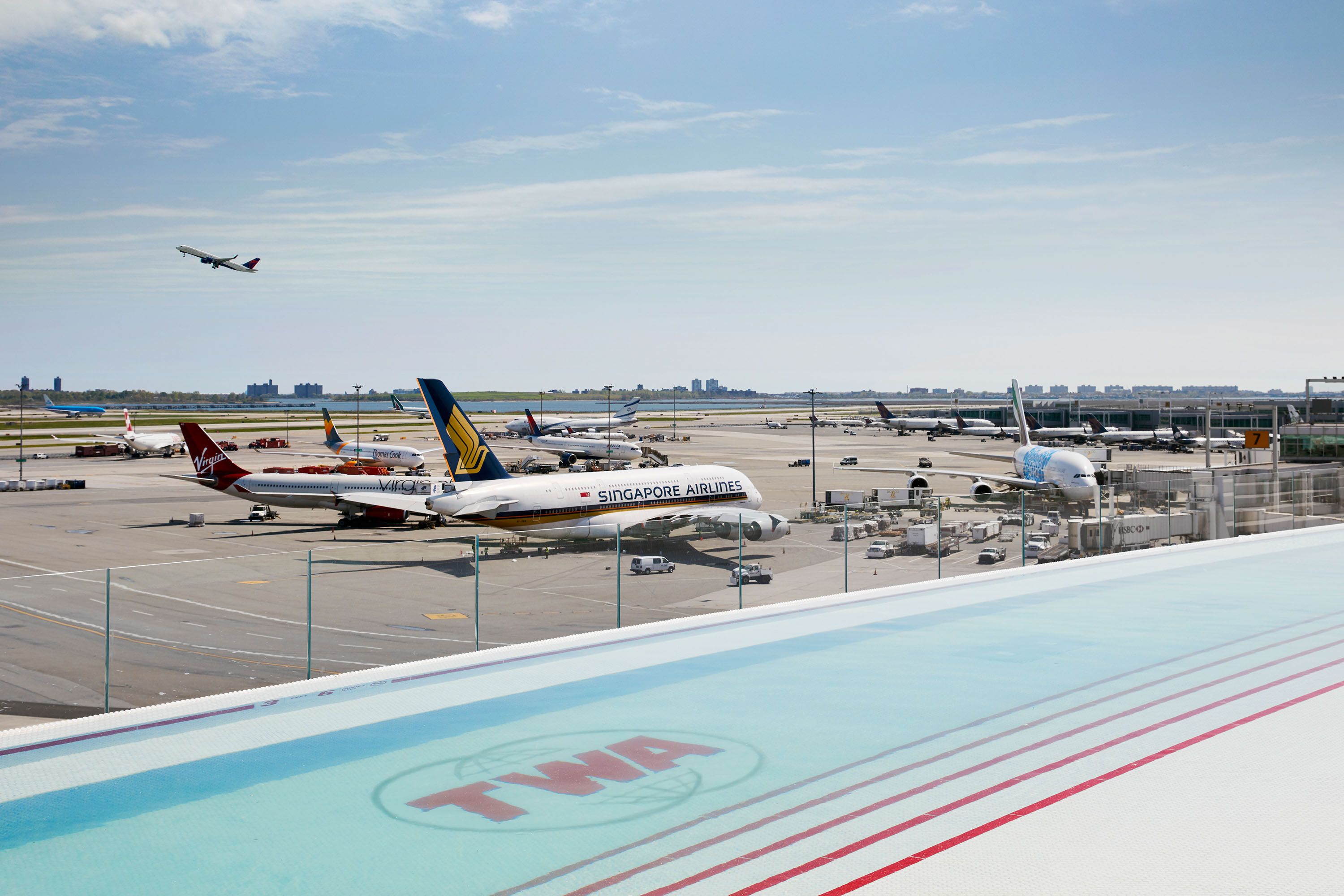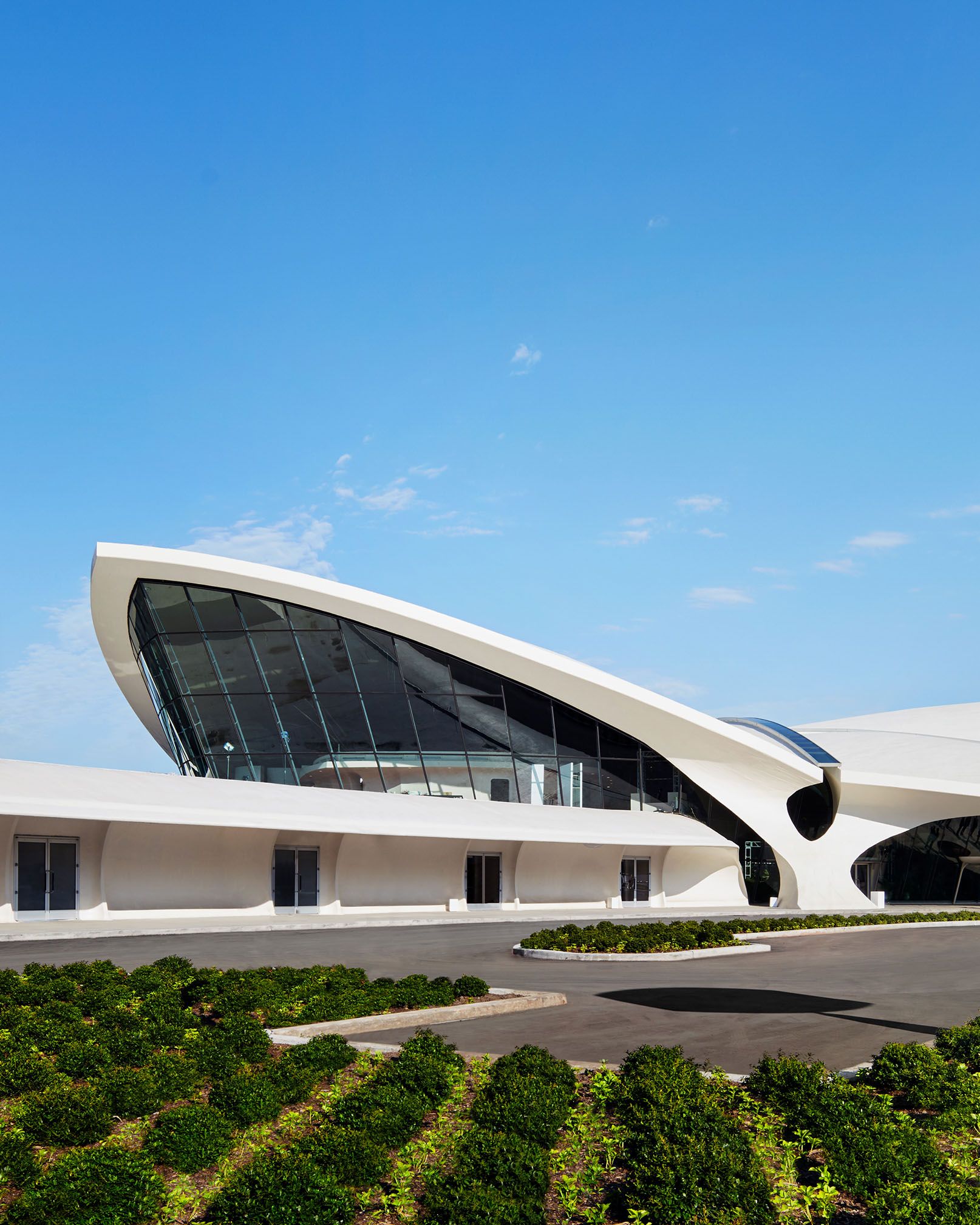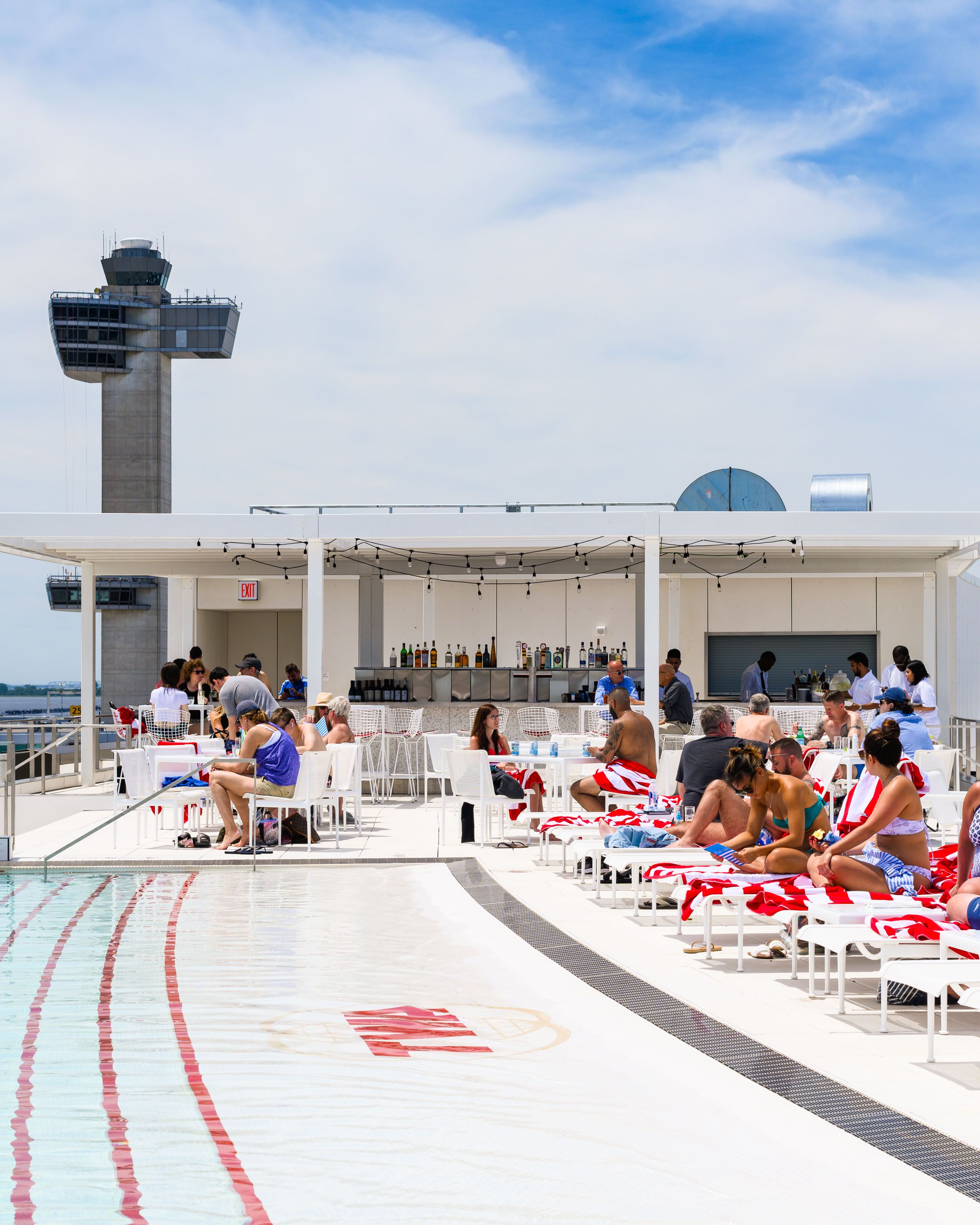The Thrill of Plane Spotting at JFK Airport
“Big bird is taking off!” Suddenly the half-dozen aviation enthusiasts who have congregated at the TWA hotel rooftop bar point their cameras and iPhones at the tarmac below us, where a double-decker A380 Emirates plane painted with gold English and Arabic lettering is revving up for its 13-hour flight to Dubai. The roar of the jet’s four engines is punctuated by a crescendo of shutter clicks, with a 1960s-hits soundtrack playing in the background at full blast.
It’s 9 a.m. on Monday morning and I’m overlooking the runways at JFK Airport’s Terminal 5 with a small group of plane spotters: Self-proclaimed aviation geeks (“avgeeks,” for short) obsessed with all things aviation, they track and record aircraft sightings—like birdwatchers but for human flight.
“They love big planes,” Peter, the cofounder of the YouTube channel LA Flights, tells me of his fellow plane spotters sitting by the pool bar, several of which are among his 363,000 subscribers. (He requested to use only his first name.) Some wear blue and orange shirts with the LA Flights motto, “One more plane,” a reference to when Peter would beg his father—who would wake him and his brother Joshua up in the middle of the night to go plane spotting as kids—to let them linger at the Las Vegas airport a little while longer. Now the brothers travel the world together broadcasting livestream airport videos nearly every day.
While plane spotting streaming is a relatively new phenomenon, the hobby far predates YouTube. It first gained popularity during WWII, when the US government urged civilians to learn to recognize enemy aircraft, resulting in 750,000 Americans volunteering to plane spot for the Aircraft Warning Service (AWS). Today’s plane spotters can still recognize different models based on visual clues—such as the shape of the plane’s nose and cockpit windows, or emergency exit door placements—but now also utilize online flight tracking tools like Flightradar24 and JetTip to pinpoint the best locations for taking photos and videos of interesting plane takeoffs and landings.

It’s a deeply knowledgeable community similar to “people who drink wine and know where the wine comes from just by tasting it,” Peter says. “You hear a plane, and you’re able to tell which engines they are—and by the engines, you know, oh, it’s this model of plane. And if it’s this model of plane, then you know it’s arriving at this time, and it’s this airline.”
Often the best vantage points for plane spotting are through chain-link fences around tarmac perimeters, or from the top of strategically positioned hillsides—and, occasionally, require some trespassing. In this world it’s well known which airports are friendly toward plane spotters, but two people I spoke to have been escorted off other properties by security guards.
With its observation deck and heated infinity pool directly overlooking the runways at JFK’s busy Terminal 5, the TWA hotel rooftop is a bucket list perch. “You get all these views of these incredible planes taking off from the runway and you have the Manhattan skyline behind you,” says Brandon Cross, a plane spotter from Miami who turned to the hobby when he couldn’t afford pilot training but still wanted to pursue a passion for aviation. “I mean, it’s iconic.”
Just as any collector has an appreciation for rarer finds, the most dedicated plane spotters track and record special plane sightings by writing down or photographing their unique tail numbers. That’s why, this week, aviation enthusiasts have traveled to the TWA rooftop from as far as California, Germany, Bermuda, and even Kazakhstan: The United Nations General Assembly is gathering in New York City, bringing dozens of heads of state—and their special-edition aircraft—to land at JFK.
“It’s the Super Bowl of plane spotting,” says Rae Kaczmarek, a 21-year-old student from Colorado who is spending the semester interning for LA Flights. When I ask what planes they’ve seen today, many spotters rattle off aircraft model numbers from memory: To the layman, it sounds like an unintelligible string of alphabet soup. On top of today’s must-see lists are the German government’s aircraft, an Airbus A350, and the South Korean presidential plane, a Boeing 747 known as Code One, as well as Air Force One, the call sign for US Air Force aircraft carrying the US president.


Around 4 p.m., Ukrainian president Volodymyr Zelenskyy will land at JFK in an Airbus A319 narrow-body airliner, and later in the evening US president Donald Trump will land in a much-larger Boeing VC-25 aircraft, soon to be replaced by a $400 million Boeing 747-8 luxury jetliner (controversially gifted to Trump by the Qatari government).
The two world leaders plan to meet on the sidelines of the UN General Assembly this week to discuss Russia-Ukraine peace negotiations. But here all that matters is the make and model of their planes. “There’s no other drama. There’s no real-world stuff,” Kaczmarek says. “It’s just like, ‘Look at how cool this plane is!’ And everybody’s like, ‘Yeah! That’s awesome!’”
It’s the third year in a row that Alicia Simmons has traveled to New York during UN Week to meet up with the LA Flights’ plane-spotting community. The 43-year-old government employee from Bermuda started watching the channel’s YouTube videos as a pastime during lockdown, when the pandemic put a pause on her real-life travel plans. By engaging with fellow viewers via the channel’s live chat feature, she says she’s been able to build meaningful relationships with avgeeks from around the world.
While these connections start as online interactions, Simmons says plane spotting has also allowed her to form in-person friendships with people like Jamie Antonio Lopez, a compliance analyst who flew to New York from California for UN Week. The community knows him best for his love of the Japan Airlines Airbus A350-1000—a plane with his initials, “JAL,” on the rudder (which the LA Flights crew now affectionately calls the Mr. Lopez–mobile).
In place of political parties, a more common allegiance to declare on the TWA rooftop is if you’re Team Stripes, meaning a fan of Condor’s aggressive green-striped livery. If you ask someone to choose their favorite plane, expect a detailed response loaded with qualifiers (“Defunct or modern model? International or domestic? Airbus or Boeing?”)—or a deep sigh followed by a heartfelt, “I love them all.”
But the community is about “more than the planes,” Simmons says. “Three weeks ago someone in the [livestream] chat said he lost his wife recently. People are tuning in just for reprieve or solace from whatever they’re going through.”

Others watch as a way to cope with their fear of flying. Pilots and air traffic controllers are often invited on the channel to answer questions about specifics relating to everything from flight routes and plane mechanics to turbulence. One frequent guest commentator is Captain Kenneth Ray, a pilot for a major US airline based in Atlanta, better known by the community as Captain Ken. In addition to expert insight on why aviation is the safest way to travel, he’ll share tidbits ranging from why you might experience a “turn and burn” takeoff (when a pilot immediately takes off from the runway without stopping first) to why he likes Airbus’s tray tables more than Boeing’s.
“Most of the people we see on airplanes today seem like they want to be anywhere else but on that airplane,” says Captain Ken, who stopped by the TWA with his wife, Christina, during a layover on their way to Italy to say hello to the plane spotters. “To be able to connect with a community like this, who love any second that they can be around airplanes, is very refreshing.”
Many plane spotters will say they fell in love with aviation at a young age but returned to the passion only later in life. It’s “the same way that we forget that we like dinosaurs, but you can go and enjoy the planes just as much as you did when you were a kid,” says Cross. “That’s joy right there—and we need that nowadays.”
For Kaczmarek, returning to plane spotting as an adult has given her a newfound appreciation for the long list of different people and moving parts playing out behind the scenes of every flight. “All the people at the gate checking your bag, the people throwing the bags on the plane, the ramp agents, the guys on the tarmac with the big glowy sticks telling the plane where to go,” she says. “There’s just so many people involved that make it all work.”
It’s a sense of reverence for the miracle of flight that all the plane spotters here seem to share: Look at planes long enough, and it’s impossible not to appreciate the engineering that allows a 400-ton metal tube to transport you across the globe in a matter of hours.
Back at the bar, looking down at the A380 taxing past, my brain struggles to picture the massive plane floating weightlessly through the sky. As we watch it take off over Jamaica Bay carrying hundreds of travelers, I too was struck by the giant machine’s graceful ascent into the clouds. “It’s kind of like magic,” Kaczmarek tells me, grinning ear to ear. “You just can’t not love it.”



